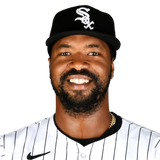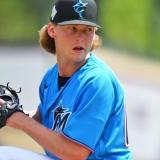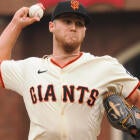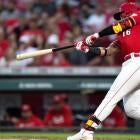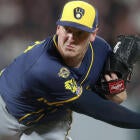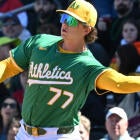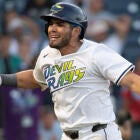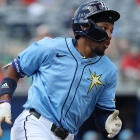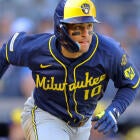What is the difference between a sleeper and a breakout? We spend a lot of time on the semantics of these words, trying to figure out which is which. For me, a breakout is a player we're projecting to do something they haven't done before. In most instances, a breakout likely offers more upside than a sleeper, too.
There are many reasons for projecting a breakout as well. It could range from prospect pedigree to underlying analytics to a change in projected playing time and anything in between.
There are some obvious picks on this list and some not so obvious. Is Eloy Jimenez being drafted too high? Well, some might argue it's not high enough. I believe if it weren't for Vladimir Guerrero Jr., you would see Jimenez go even higher. As for Max Fried, he won 17 games last year, but the surface numbers and strikeouts actually point to another level they can get to. And J.D. Davis was helped out big time by the addition of the universal DH, and his Statcast numbers are incredible. For guys like Alex Verdugo and Mitch Keller, we're looking at top prospects who finally have the opportunity to prove themselves.
Breakouts come in many fashions but they all have one thing in common: They're all going to seriously outperform their average draft position.
| ||||||||||
Let's get the obvious breakout candidate out of way first. Many are on the bandwagon this year, as you can see from his steep 59.4 ADP. For perspective, he's currently going ahead of Joey Gallo, Giancarlo Stanton, and Jorge Soler among outfielders. The expectations are sky-high, and they should be. Entering last season, Jimenez was considered among the top prospects in the game, up there with the Vladimir Guerrero Jr.'s of the world. This season they're going back-to-back in ADP despite Jimenez's 31 home runs being much more useful than anything Guerrero provided in 2019.
It was an up-and-down season for the rookie, and a few injuries that plagued him along the way didn't help. When he returned in August, however, he gave us a glimpse of his upside. Over his final 52 games, Jimenez hit .308 with 14 home runs and a .917 OPS. That's a 40-homer pace over 150 games. His .917 OPS during that stretch was 16th among outfielders and higher than the likes of Ronald Acuña, Cody Bellinger, and Charlie Blackmon.
What separates Jimenez from other outfield sluggers is his hit tool. Throughout his minor league career, Jimenez carried a .311 batting average. While I don't think he'll do that in the majors, .280-.290 is realistic. For a young lad, he makes exceptional contact, which is backed up by the Statcast data. Last season his, xSLG, average exit velocity, barrel rate, and hard-hit rate all ranked in the 86th percentile or higher among qualifiers. Jimenez's last step for a full breakout is lowering his 47.9% ground ball rate. He's likely more useful in Roto or H2H categories because of his middling plate discipline but if he breaks out like I think he will, you're still going to want him in points leagues, too.
| ||||||||||
I'll just go all the way out there and say come draft season 2021, we'll be drafting Fried as a top-20 starting pitcher inside the first four rounds. Considering he's currently SP37 off the board at pick 132, that's a fair amount of value to gain. What's not to like? He's 26 years old and won 17 games last year while striking out over a batter per inning. On the surface his 4.02 ERA and 1.33 WHIP were not exciting but there's reason to believe those numbers will improve.
First off, while his ERA was 4.02 last season, his xFIP was 3.32, suggesting he was quite unlucky. Heck, he already started improving in 2019. Fried lowered his ERA from 4.29 in the first half to 3.63 in the second half. How? He upped his slider usage by 5.5%, which helped raise his strikeouts in that second half (10.2 K/9) while lowering his walks (2.42 BB/9). There were only 13 qualified starting pitchers who managed a K/9 over 10 with their BB/9 under three.
On top of all that, Fried is an elite ground ball pitcher, with a 53.6% rate. Unlike other young pitchers, Fried has an MLB-ready arsenal featuring three useful pitches. His fastball sits in the mid-90's (with cut at times), with a mid-80's slider, and a big loopy curveball. He checks all the boxes. My one cause for concern was his struggles with walks in the past. Based on the improvements I saw in-season last year, I'm not so worried about that anymore. If you're looking for this year's Shane Bieber, I think Fried can be that guy.
| ||||||||||
Scott White and I don't always agree on things and that's okay. Differing opinions helps us see both sides of the story. Davis is one player we're on the same page on for 2020, however.
Entering last season, we weren't quite sure what Davis' role would be with the Mets, despite impressive minor-league numbers. He wound up batting .307 with 22 home runs and an .895 OPS across 453 plate appearances. That sport of came out of nowhere, but you shouldn't be too skeptical about it. Take a look at his Statcast numbers below:

What you see there is a whole lot of red. When it comes to Statcast, red is good. J.D. Davis makes an incredible amount of hard contact. So much so that his .308 expected batting average ranked in the 97th percentile. Only eight qualified hitters ranked ahead of him last season. While his 47% ground ball rate is still a tad high for my liking, it was a career-low as he continuously increases his launch angle.
And finally, we shouldn't have any worries over playing time anymore, either. With the universal DH being implemented this season, Davis should routinely find his way into the lineup. He's a target in both formats, as his plate discipline is solid and he can contribute in both batting average and home runs.
| ||||||||||
Many injured players benefited from the season being delayed, and Verdugo is definitely one of them. If the season had started on time, Verdugo was nearly a guarantee to miss time with a back injury. On a conference call back in May, however, he deemed himself 100% healthy. Verdugo was the prized possession in the Mookie Betts blockbuster earlier this year and for good reason. There is a lot in his profile that suggests he can develop into a Michael Brantley type, maybe even better.
Verdugo finally earned a chance at extended playing time last season and did not disappoint. He hit .294 with 12 homers, 43 runs, and 44 RBI in just 377 plate appearances. What impressed me most was his plate discipline and his splits. His 13% strikeout rate ranked in the 93rd percentile last season. He's never struck out more than 16.3% at any level.
In terms of his splits, he reminded us that he can handle his own against left-handed pitching, too, actually hitting better against lefties in 2019, batting .327 with an .843 OPS compared to .281 and .807 against righties. That should help keep him on the field and playing regularly with the Red Sox in 2020. Verdugo is a better bet in points leagues because he doesn't strike out much and should hit a decent amount of doubles. Given his prospect pedigree, there's chance he explodes with the opportunity to finally play every day.
| ||||||||||
Mitch Keller and Corbin Burnes are pretty much the faces of positive regression in 2020. Don't be fooled by their surface stats. Yes, a 7.13 ERA and a 1.83 WHIP for Keller as a rookie are disgusting. His 12.19 K/9 and 3.47 xFIP are much more intriguing, however. He's just not going to maintain a .475 BABIP and a 59.6% strand rate, either. As those move toward league average coupled with that strikeout rate, you have a breakout on your hands.
Keller is a former second round pick for the Pirates who enjoyed success throughout his minor-league career. In 539.1 innings, Keller posted a 3.12 ERA and a 1.16 WHIP with 566 strikeouts. He boasts a mid-90's fastball with a plus slider and curveball. Based on the small sample size from last season, the slider especially really has a chance to be a special pitch. He threw 157 of them in 2019, posting a 26.8% swinging strike rate and a 50.5% chase rate. To put that in perspective, Justin Verlander's slider graded out as the best in baseball last season, according to Fangraphs pitch values. His slider produced a 24% swinging strike rate and a 53.5% chase rate. That's a pretty good slider you've got there, Keller!
Oscar Marin taking over as Pirates pitching coach should also help Keller. Marin is more in tune with analytics than former pitching coach Ray Searage, which means we should expect more secondary pitches this season, a la that slider. Keller has legitimate Top-30 starting pitcher potential and is currently as the 73rd SP off the board.
![[object Object] Logo](https://sportshub.cbsistatic.com/i/2020/04/22/e9ceb731-8b3f-4c60-98fe-090ab66a2997/screen-shot-2020-04-22-at-11-04-56-am.png)


